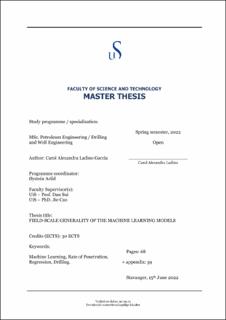| dc.description.abstract | Drilling performance is directly related to fundamental aspects such as drilling variables that can affect the performance of the operation, the well stability, efficiency of drilling equipment, use of new technologies and operational parameters. Approximately 30% of the total time of construction of a well corresponds to the time rotating and sliding, in this order of ideas the optimization of the rate of penetration “ROP” has a direct impact on time and cost reduction. This reduction has as an added value: making viable economically the drilling campaigns and development of the fields. That is why one of the main objectives of the operating companies is to reduce the total time in which the true depth is reached, to reduce the costs of the operation but without affecting the main objective of the well drilling operations. To consider a good performance of the operations, many factors are involved being the rate of penetration one of the most important, without leaving behind the HSE performance, the stability of the well, integrity of the formation and final cost of the project.
On the other hand, the data driven machine learning models are significantly different in conception process from physics-based models. The physic-based models try to understand the problem and propose proper models resembling he problem under certain assumptions and constraints. They seek methodology to reasonably determine the results given input. On the contrary, the machine learning models consider little about the details of the problem but train a working model mapping directly from inputs (knowns) to outputs (unknowns) through a black box of neutral networks. After that, researchers try to unveil the black box to analyze what happens there and enlighten what knowledge learned from there as to improve the model interpretability.
Along the project, the relevant parameters for the machine learning predictive model were chosen considering the correlation and their dependency to ROP, the model was fed up, trained, and tested with the data set of one well and its accuracy was improved using hyperparameter tunning. After it, the algorithm was tested with five different data sets keeping constant the chosen parameters. Among them it was possible to determine that the Random Forest, Gradient Boosting and K Neighbors regressor were the ones with the highest coefficient of determination and the best performance, considering that any model in general can be improved reckoning also the importance of the learned lessons or field experience from petroleum engineering knowledge to enhance the quality of the inputs and the outputs of the model. | |
